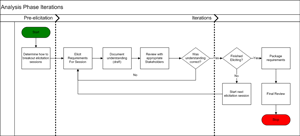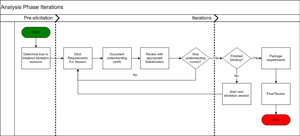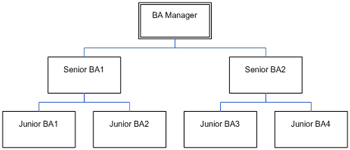If you want to separate yourself from other BA professionals in the market, please read on.
Here is a quick background to the story. In the early 1990s I was working as an accountant and bored to tears. My father was proud because I was using my college degree to earn a living. As you all know using your college degree is not necessarily the reason you should stay in a career. To help with the boredom I started going to see a lot of stand-up comedy. One night I caught one of Jimmie “JJ” Walker’s shows. You remember him, right? He coined the phrase “Dy-no-mite” on the show Good Times. I could not believe it…he was terrible! That night I turned to my girlfriend, now wife, and said “I can do this.” I started working the open mic night circuit in Atlanta then auditioned for an Improv troupe. When I was selected for the troupe after the audition, I never went back to stand-up.
Throughout the 1990s I rarely missed a weekend being on stage and practicing two to three nights during the week. Over that time, I transitioned from an accountant and subject matter expert for PeopleSoft Financials into a business analyst role working on PeopleSoft implementations.
I no longer perform with a troupe, but I use much of what I learned as an improv comedian every day to help me succeed in my role as a business analyst.
Why should you care? The skills I am about to share with you focus on the most important skills to elevate your career as a business analyst. It has nothing to do with 99% of the skills most people discuss like use cases, workflow diagrams, etc. All of those are important, but most BAs can learn when and how to use those techniques. In my opinion, learning those techniques is the foundation for being a great BA. You need to separate yourself. The skills learned from my improv days will help you break free from the rest.
First, let me give you a little background on Improvisational Comedy from wikipedia.
“Improvisational theatre (also known as improv or impro) is a form of theatre in which the improvisational actors/ improvisers use improvisational acting techniques to perform spontaneously. Improvisers typically use audience suggestions to guide the performance as they create dialogue, setting, and plot extemporaneously. The basic skills of listening, clarity, confidence, and performing instinctively and spontaneously are considered important skills for actors to develop.”
Here are five lessons from my improv days that if you work on will help you be a better analyst and separate you from the pack.
1) Over-Prepare then Go with the Flow
To be spontaneous on stage, my troupe would practice relentlessly so that we could relax on stage and let the scenes take shape as we performed. Since there are no scripts in improv we would practice being comfortable not having scripts. The more we practiced, the more prepared we were for any situation on stage. In business analysis the more prepared you are for a meeting with stakeholders the smoother it will go. Make sure you know what you are trying to accomplish with every meeting and have a list of questions you want to cover in an interview. Then when you have that meeting, go with the flow. Don’t go down your list of questions one by one. Have a conversation with your stakeholder. Let your stakeholder speak about the topic you want to learn more about and ask clarifying questions to make sure you touch on all the points you wanted to cover. You’ll get your questions answered and then some.
2) Never Deny
Never say no. In improv if someone walks into a scene and exclaims “Wow, I love that you colored your hair yellow,” you never say “it’s not yellow.” That denial instantly puts the burden back on the other actor to come up with something else. It kills the scene. If you did it enough the other actors wouldn’t want to “play” with you anymore. In business analysis, our business stakeholders come to us with changes in scope. This will always happen, so accept it. If you always say “No, sorry that was not in scope”, your stakeholders won’t want to “play” with you anymore. After clarifying the need I’ll say something like “we can definitely add that feature, let me work with the team to see what the impact on the cost and schedule will be. Then we can discuss if you still want to include it in this release.” Doesn’t that sound so much better? You keep the dialogue moving forward. You come across as a team player. By not denying you help make an informed decision on how to move forward.
3) Always Give 100%
I can still remember a scene where I had to come in as a boy from England. One thing I was never good at was accents. But, I had to go for it. I could not leave the other actors out there. I squeaked out a few words in an English accent and then fell into my standby Latino accent. I came across so believable because I did it with confidence. I worked into the scene somehow that I was a long lost cousin that came to live with family and never lost my accent. The crowd loved it. As business analysts we need to be confident when presenting to an audience, facilitating a requirements workshop, in a one on one interview, and all other interactions we have with our team and business stakeholders. Confident, not cocky! In what ever you do give it 100%. You can always look back later and see how you can improve. I still can’t get an English accent right to this day!
4) Don’t Anticipate
In improv you can not anticipate your lines. You need to listen intently on what the other actors are saying and then develop your lines as you go. The minute you stop listening to come up with a line, you are done. Most likely your line will not make sense. When you are eliciting requirements you need to actively listen to your stakeholders and not anticipate their answers. Many of us have industry knowledge and assume we know the answers to some of the questions. Remember you are not the subject matter expert. There is a reason you are talking with the stakeholder. Listen to their response and then clarify their response by developing follow-up questions.
5) Include Your Audience
Improv is all about including your audience. We would get suggestions for topics to incorporate in scenes, we often went off stage and continued scenes in the audience, and we even brought some audience members on stage. By including your audience in this matter we would break the fourth wall, as they say in the biz! So many people love improv theatre because they feel part of the act. As analysts you need to break the fourth wall with your audience. Requirements elicitation, analysis and communication are team sports. Don’t sit in your office and document requirements the way you think they need to be documented. Get everyone involved in your planning and consistently include your audience in reviews, let them know your status. This will make everyone feel a part of the effort and take responsibility for its success.
Best of luck with your next improvised day.
Kupe
Don’t forget to leave your comments below
Jonathan “Kupe” Kupersmith is Director of Client Solutions, B2T Training and has over 12 years of business analysis experience. He has served as the lead Business Analyst and Project Manager on projects in various industries. He serves as a mentor for business analysis professionals and is a Certified Business Analysis Professional (CBAP) through the IIBA and is BA Certified through B2T Training. Kupe is a connector and has a goal in life to meet everyone! Contact Kupe at [email protected]
Follow me on Twitter, http://twitter.com/Kupe






 Jerry Jones, the owner of the Dallas Cowboys, who I do not love since I am a NY Giants fan, had a pet feature for this stadium…sixty yard long, high definition screens that are 90 feet above the field and run along the side lines.
Jerry Jones, the owner of the Dallas Cowboys, who I do not love since I am a NY Giants fan, had a pet feature for this stadium…sixty yard long, high definition screens that are 90 feet above the field and run along the side lines.